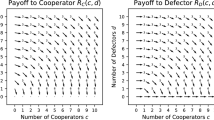Abstract
A non-constant-sum continuous game analyzed in a previous paper by one of the authors (A. Rapoport,Bull. Math. Biophysics,18, 15–30, 1956) is extended from two toN players with special emphasis onN=3. It is shown that the concept of stability becomes in this case one of “pairwise stability,” and depends on the so-called distribution matrix of rewards. The distribution matrix and the collusion structure jointly determine the end states of the game. Conditions which lead to the emergence of one, two, or no “parasites” are derived. An apparatus is described which provides a physical analogue of the game, making possible the isolation of behavioral variables under the prescribed conditions of the game.
Similar content being viewed by others
Literature
Rapoport, A. 1956. “Some Game-Theoretical Aspects of Parasitism and Symbiosis.”Bull. Math. Biophysics,18, 15–30.
Rashevsky, N. 1951.Mathematical Biology of Social Behavior. Chicago: The University of Chicago Press.
Author information
Authors and Affiliations
Rights and permissions
About this article
Cite this article
Foster, C., Rapoport, A. Parasitism and symbiosis in an N-person non-constant-sum continuous game. Bulletin of Mathematical Biophysics 18, 219–231 (1956). https://doi.org/10.1007/BF02481857
Received:
Issue Date:
DOI: https://doi.org/10.1007/BF02481857




